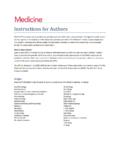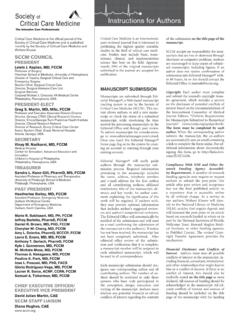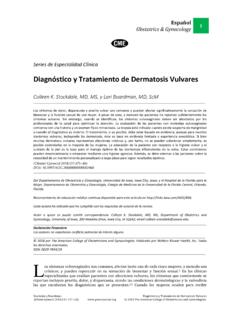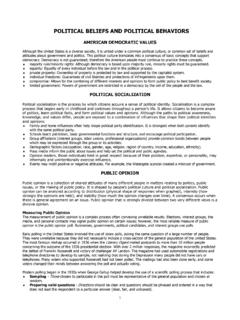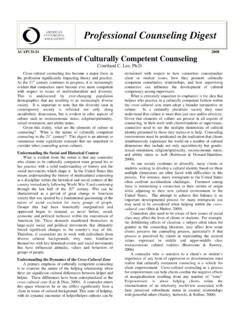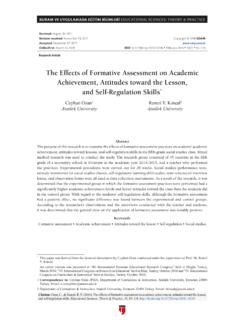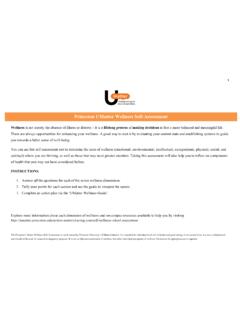Transcription of Reviewer Comments to Author(s): Reviewer #1 (Jillon Vander ...
1 Reviewer Comments to Author(s): Reviewer #1 (Jillon Vander Wal, PhD): Overall, this is a clear, concise, and well-written manuscript. The introduction is relevant and theory based. Sufficient information about the previous study findings is presented for readers to follow the present study rationale and procedures. The methods are generally appropriate, although clarification of a few details and provision of a rationale for the use of this particular method of measuring eating disorder symptoms should be provided. Overall, the results are clear and compelling with two possible exceptions. The use of the word path analysis suggests the use of a certain analytic technique which does not appear to have been used. Also, use of the word "step" has more than a single interpretation. The authors make a systematic contribution to the research literature in this area of investigation.
2 The longitudinal nature of the work, albeit with college students, is a welcome addition. Overall, this is a high quality manuscript that has implications for the theoretical basis, development, and maintenance of disturbed eating attitudes and behaviors; however, the relevance to nursing per se is uncertain. Specific Comments follow. Introduction p. 2, lines 3 - 6: The term "ranging from" suggests that there must be a "to." p. 2, line 14 and p. 4, line 3: Please change "&" to "and." p. 3, line 3; p. 5, line 10; p. 5, line 13; p. 17, line 12; p. 18, line 3: First person is generally to be avoided. As this is an extension of a previous study, this becomes more challenging. p. 3, line 16: The word "to" should be inserted between "referred" and "as." p. 3, line 19: The word "of" should be inserted between "pattern" and "information." p.
3 5, line 7: The word "participants" would be a better word choice than the phrase, "clinical samples." p. 5, line 21: Change "yr" to "year." Methods p. 6, line 23: Referring to scores on the EDI subscales as attitudes is rather unusual. Suggest changing the word " attitudes " to "scores." p. 7, lines 3 - 9: It would be helpful to perform a Chi-Square to determine if a greater percentage of women from the DEB group than the control group discontinued participation. p. 8, lines 4-5: Providing an estimate of the test-retest reliability would be helpful. p. 8, lines 7-8: The reference to Markus should appear prior to the references to Rogers. p. 9, line 2: Please provide the number of participants who failed to respond to at least 7 of the 10 fat words and to 7 of the 10 control words and who were thereby deleted from the latency analyses.
4 If more than a few, specify the number deleted by group. p. 10, lines 1-12: The method of measuring engagement in eating disordered behaviors is rather ideosyncratic. For instance, the EDE-Q or QEWP could have been used. A statement in this section or in the discussion justifying the use of this methodology is warranted. p. 10, lines 10-12: The name of the diagnostic screening interview used should be provided along with the correlation between that measure and the measures of eating disorder behaviors. p. 10, line 18: It appears that the EDI was used, but not described. It may be best to let it be subsumed under the "other measures not reported here." As an aside, the full name should be provided the first time an instrument is mentioned and version three is now standard. p. 10, lines 20-21: Please clarify whether height and weight were measured via self-report or by in vivo methods.
5 Results p. 13, lines 7 - 12: This section appears to be a continuation of the preceding paragraph. Use of a new heading is confusing. p. 13, line 21: Check to see if "F<1" should be "p < 1." p. 14, lines 4 - 7: Adding an explanation why variables on which the DEB and control groups did not differ ( number of positive self-schemas and interrelateness) seems warranted. p. 14, lines 15 - 19: This Reviewer was under the impression that path analyses were used and was therefore looking for fit indices. Use of regressions is fine, but the presentation is a little confusing. It appears that two regressions were run, 1) BMI, # of positive self-schemas, # of negative self-schemas, and inter-relatedness as predictors of the fat self-schema score and 2) BMI, # of positive self-schemas, # of negative self-schemas, inter-relatedness, and the fat self-schema as predictors of ED behaviors.
6 The use of the word "step" may lead some to think that a single regression with multiple blocks was conducted. This Reviewer hopes that these impressions are correct; if not, the authors may wish to clarify their analytic procedures in this section. p. 15, line 5: Figure 2 was not included in the manuscript. p. 16, line 12: Consider inserting the word "negatively" between "self-schemas" and "predicted." Discussion p. 17, line 11: Consider deleting the last "the." p. 17, line 23: Consider adding the word "the" between "in" and "level" and adding an "s" after the word "month." It would be helpful to comment on the fact that the DEB and control women in this study, in contrast to the previous study, did not differ with regard to the number of positive self-schemas. At least some discussion of this finding seems warranted. References: Header should be centered.
7 Tables: Clear. ** Reviewer #2 (Michael Rice, PhD, ): Outstanding study and well done. There are only two issues associated with Publication 1. There is no mention of Human Subjects IRB and informed consent. I am sure this was done but a sentence or two must be included prior to publication. 2. On page 10, in the procedure section, the author(s) mention that the participants were informed this was a study on how college women thoughts affected their health. while this is a mild deception and did reduce experiemntor effects. Were the subjects ever informed of the true nature of the study. If so when and if not then why not? Once these questions are addressed, the article should be published. ---------------------------------------- ------------------------------ CHECKLIST FOR STYLE Title Page: Supply professional title for each author.
8 Abstract: Supply 2-3 keywords. Text: Reduce # of pages ( 14-16 pages , regular article) References: 1) Add in-text citations of the following references to the reference list: Stein & Hedger, 1997 2) The following references are not cited in the text. Remove from reference list or add to text: Marcus & Kunda, 1986 1998 3) Check publication date for Streigel-Moore 2002 or 2006? Figures: Figure 1: Provide a different filler for the "negative" graph bar, maybe a solid, not pattern. As is, it cannot be distinguished.
